The launch conductor is leading a terminal count briefing with the launch team. There are three control rooms: the United Launch Alliance’s Atlas Spaceflight Operations Center on the Cape Canaveral Air Force Station; the Boeing Mission Control Center at Kennedy Space Center; and the Space Station Control Room at Johnson Space Center in Houston. NASA’s Emergency Operations Center also is activated, and United Launch Alliance has teams in Denver who will monitor ascent of the rocket.
Category: Boeing
Meet Rosie – Boeing’s First Anthropometric Starliner Commander
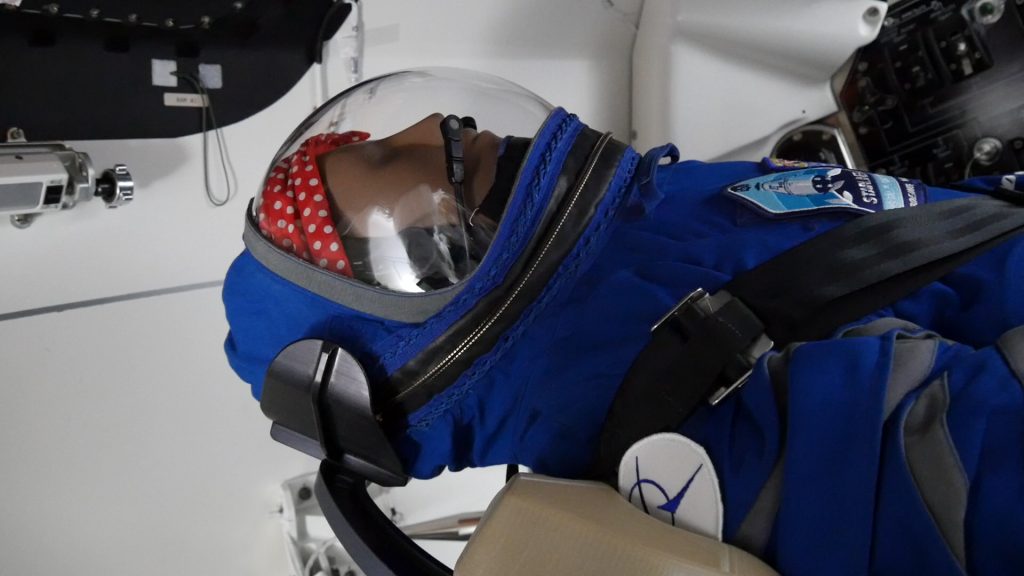
Onboard Boeing’s CST-100 Starliner is an anthropometric test device, called Rosie, who will provide a wealth of information about what astronauts will

experience during flight aboard the spacecraft. Boeing named the test device after Rosie the Riveter, an icon who inspired women to join aerospace. Rosie’s 15 sensors will collect valuable data during the mission that will help make future crewed missions safe on Starliner.
Everyone’s favorite –Snoopy – is making his return to space aboard the Starliner spacecraft.
Teams Clearing the White Room at Space Launch Complex 41
Preparations are underway for the launch of the Atlas V rocket with Boeing’s CST-100 Starliner atop at Space Launch Complex 41 on Cape Canaveral Air Force Station in Florida. The combined White Room Crew of Boeing and United Launch Alliance are closing and securing the white room, performing cabin leak checks of the CST-100 Starliner and clearing the white room. The team will clear the crew access tower and drive to a safe distance from the launch pad.
The Atlas V Rocket for Boeing’s CST-100 Starliner Launch
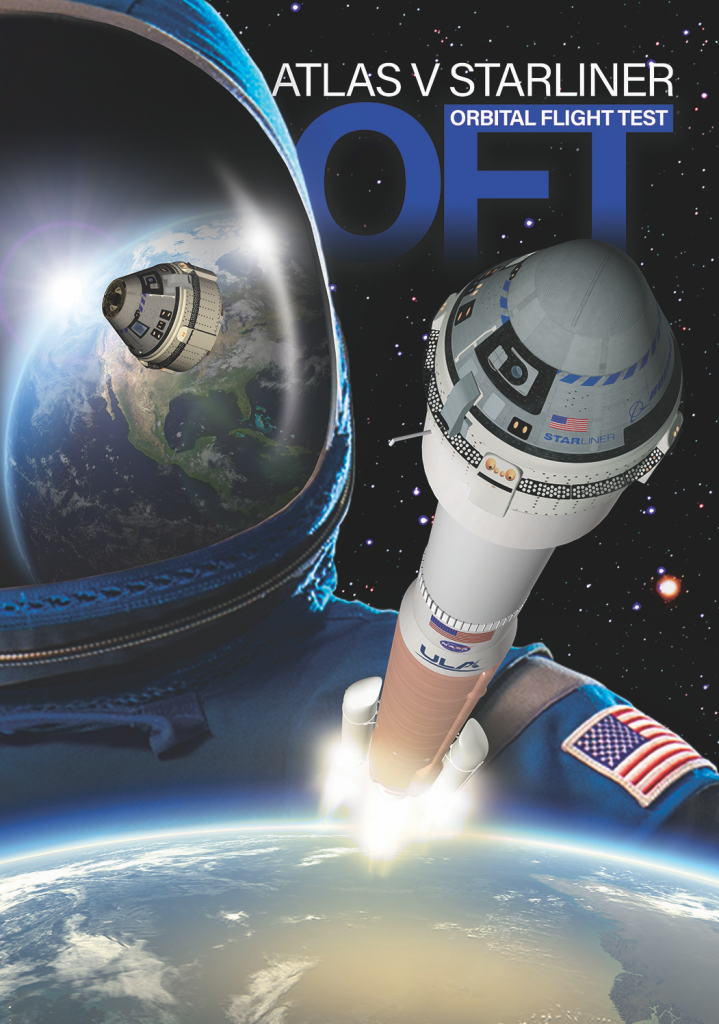
The Atlas V rocket that will launch Boeing’s CST-100 Starliner was modified specifically for this launch. It is designated N-2-2. The “N” signifies that the rocket configuration does not include a payload fairing. Instead, the Starliner’s own protective surfaces will take the place of the fairing to protect the uncrewed spacecraft during ascent. The 2-2 designates the rocket has two solid rocket motors and a dual-engine Centaur upper stage. The Starliner is attached to the Atlas V using a launch vehicle adapter, which includes an aeroskirt to reduce the aerodynamic loads on the vehicle.
The Atlas V booster is 12.5 feet in diameter and 106.5 feet in length. The booster’s propulsion is provided by the RD-180 engine system, which delivers 860,200 pounds of thrust at sea level. The two SRBs generate the additional power required at liftoff, with each providing 348,500 pounds of thrust.
The Centaur second stage is 10 feet in diameter and 41.5 feet in length. For this configuration, the Centaur is configured with dual RL10A-4-2 engines, each producing 22,600 pounds of thrust. The cryogenic tanks are insulated with a combination of helium-purge blankets, radiation shields and spray-on foam insulation. The Centaur includes an Emergency Detection System that monitors for critical hazards. This system will provide critical in-flight data, which supports jettison of the ascent cover and initiates CST-100 spacecraft separation.
The Starliner Orbital Flight Test will be the 81st launch of the Atlas V and will mark ULA’s 136th mission.
Learn more at www.ulalaunch.com.
Boeing’s CST-100 Starliner Ready for its Inaugural Flight

Boeing’s CST-100 Starliner is a 21st century human space transportation platform for use on missions to low-Earth orbit. The crew and service modules together are 16.5 feet high. Starliner’s diameter is 15 feet. For its design, Boeing leveraged decades of heritage in human spaceflight as well as included new technologies to make a safe and reliable vehicle. Starliner’s two main pieces are the crew module and service module. The crew module is intended to be reused for up to 10 missions.
Learn more at www.boeing.com/Starliner.
Boeing’s Orbital Flight Test Mission Objectives
 The main objective of Boeing’s Orbital Flight Test is to dock with the International Space Station and prove its autonomous mission capability. The mission will demonstrate on-orbit operation of Starliner’s systems, including avionics, docking system, communications/telemetry systems, environmental control systems, solar arrays and electrical power systems, and the propulsion system. These mission objectives are intended to demonstrate all of Starliner’s systems and capabilities, except for those requiring a human onboard to test.
The main objective of Boeing’s Orbital Flight Test is to dock with the International Space Station and prove its autonomous mission capability. The mission will demonstrate on-orbit operation of Starliner’s systems, including avionics, docking system, communications/telemetry systems, environmental control systems, solar arrays and electrical power systems, and the propulsion system. These mission objectives are intended to demonstrate all of Starliner’s systems and capabilities, except for those requiring a human onboard to test.
Atlas V and Boeing CST-100 Starliner Ready for Launch
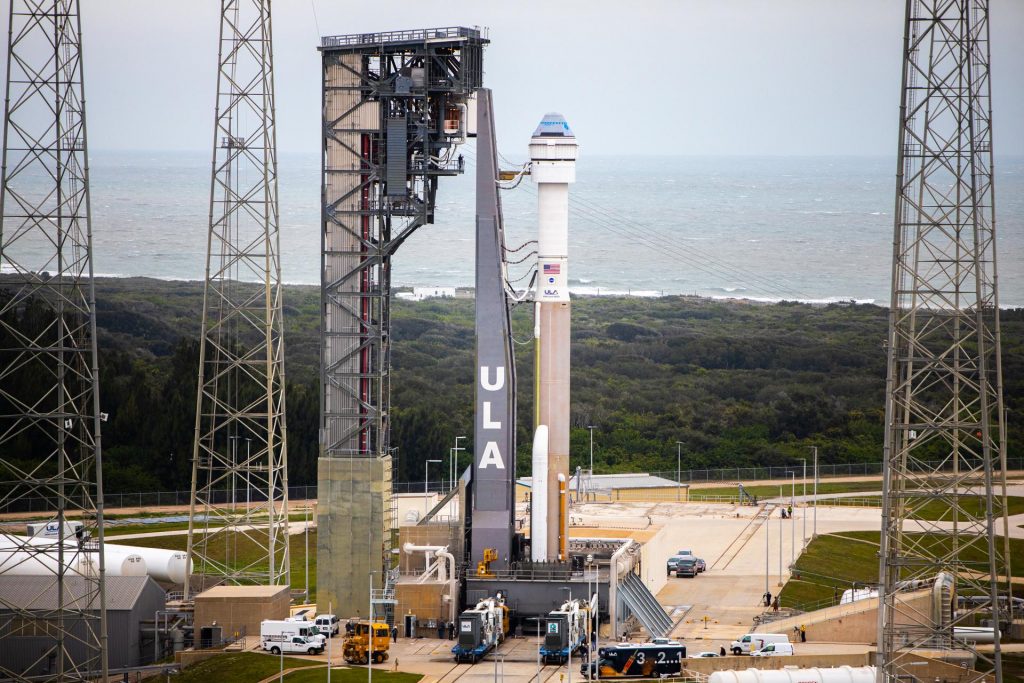
Good morning from the NASA News Center at Kennedy Space Center in Florida. It’s launch day for Boeing’s CST-100 Starliner spacecraft. The United Launch Alliance Atlas V rocket, with Starliner atop, are poised on the launch pad at nearby Space Launch Complex 41 on Cape Canaveral Air Force Station.
Starliner will make its inaugural flight to the International Space Station, called Orbital Flight Test, as part of NASA’s Commercial Crew Program. Liftoff is scheduled for 6:36 a.m. EST during an instantaneous launch window.
Fueling of the Atlas V rocket began at about 12:30 a.m. today. The first stage booster’s RD-180 engine, containing two thrust chambers, was fueled with Rocket Propellant-1 (RP-1), or highly purified kerosene. The Centaur second stage was fueled with liquid hydrogen and liquid oxygen. Fueling of the rocket was completed about two hours later.
Stay tuned for coverage of the countdown events and launch. Watch the coverage live on NASA TV. More details about the mission and NASA’s Commercial Crew Program can be found in the online press kit and by following the @commercial_crew on Twitter and commercial crew on Facebook.
Meteorologists with the U.S. Air Force 45th Weather Squadron continue to predict an 80% chance of favorable weather for launch early this morning. Primary concerns for launch day are the Cumulus Cloud Rule and User Ground Winds violations during the instantaneous launch window.
Tune in for Launch Coverage of Boeing’s Orbital Flight Test
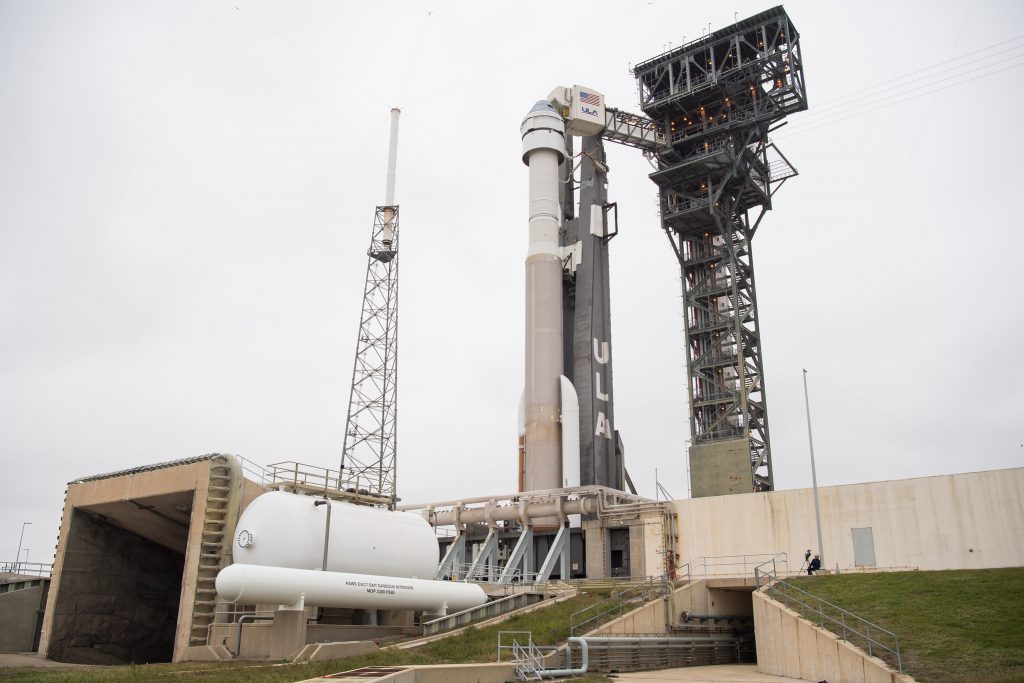
Liftoff of Boeing’s CST-100 Starliner spacecraft atop a United Launch Alliance Atlas V rocket, is targeted for 6:36 a.m. EST Friday, Dec. 20 from Space Launch Complex 41 on Cape Canaveral Air Force Station in Florida. This uncrewed mission, known as Boeing’s Orbital Flight Test, is Starliner’s maiden flight to the International Space Station for NASA’s Commercial Crew Program. The main objective of the mission is an end-to-end demonstration of Boeing’s ability to launch astronauts to the orbiting laboratory and return them home. To learn more, read the prelaunch feature.
Meteorologists with the U.S. Air Force 45th Weather Squadron continue to predict an 80% chance of favorable weather for launch on Friday morning. Primary concerns for launch day are the Cumulus Cloud Rule and User Ground Winds violations during the instantaneous launch window.
Join us at 5:30 a.m. Friday, Dec. 20, for countdown coverage on the Commercial Crew blog and NASA TV.
NASA will host an Administrator Post-launch News Conference at 9 a.m. followed by a Launch Team News Conference at 9:30 a.m., both on NASA TV.
Mission Timeline (all times approximate)
Hour/Min/Sec Events
-06:00:00 Atlas V fueling commences
-04:05:00 Atlas V fueling is complete
-04:04:00 T-4 minute built-in hold begins
-01:25:00 Hatch closure complete
-01:15:00 Prelaunch cabin leak checks
-01:05:00 Cabin pressurization complete
-00:20:00 Launch Conductor conducts terminal count briefing
-00:18:00 CST-100 poll for terminal count
-00:15:00 CST-100 to internal power
-00:10:00 Crew Access Arm retracted
-00:08:00 Launch vehicle poll for terminal count
-00:04:45 Starliner configured for terminal count
-00:04:00 T-4 minute built-in hold releases
-00:01:00 CST-100 is configured for launch
-00:00:03 RD-180 engine ignition
Launch, Landing and CST-100 Deployment (all times approximate)
Hour/Min/Sec Events
+00:00:01 Liftoff
+00:00:06 Begin pitch/yaw maneuver
+00:00:41 Maximum dynamic pressure
+00:01:05 Mach 1
+00:02:22 SRB jettison
+00:04:29 Atlas booster engine cutoff (BECO)
+00:04:35 Atlas Centaur separation
+00:04:41 Ascent cover jettison
+00:04:45 Centaur first main engine start (MES-1)
+00:05:05 Aeroskirt jettison
+00:11:54 Centaur first main engine cutoff (MECO-1)
Briefing with NASA Administrator for Boeing’s Orbital Flight Test on NASA TV
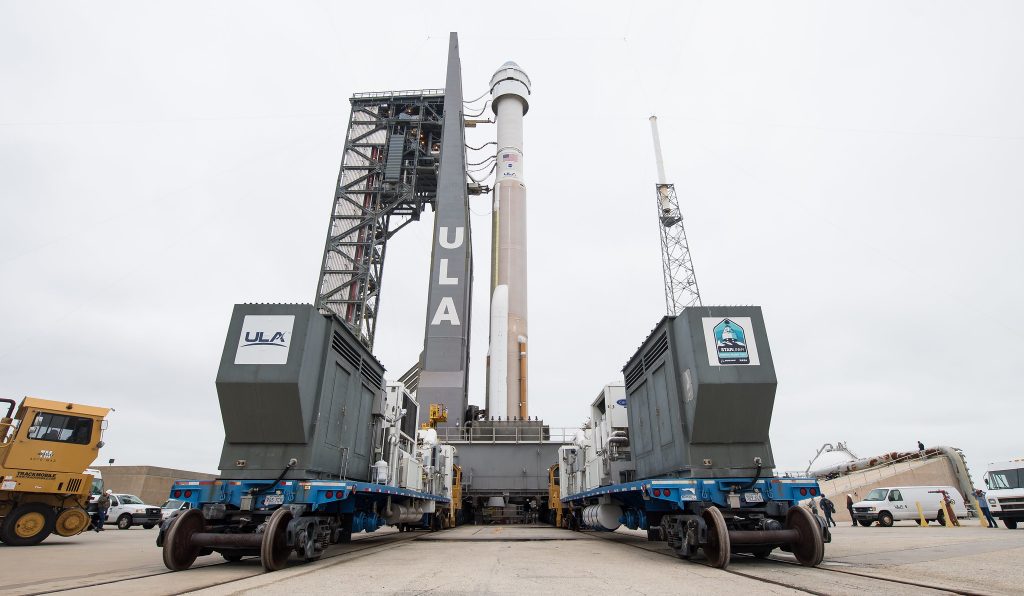
At 9:30 a.m. Thursday, Dec. 19, NASA will host a news briefing with the agency’s Administrator at Kennedy Space Center. Participants are:
- Jim Bridenstine, NASA Administrator
- Robert Cabana, director, Kennedy Space Center
- Josh Cassada, NASA Astronaut
- Mike Fincke, NASA Astronaut
- Nicole Mann, NASA Astronaut
- Suni Williams, NASA Astronaut
- Chris Ferguson, Boeing Astronaut
The launch of Boeing’s Orbital Flight Test to the International Space Station, as part of NASA’s Commercial Crew Program is targeted for 6:36 a.m. EST Friday, Dec. 20.
Starliner Ready for its Inaugural Flight

Boeing’s CST-100 Starliner spacecraft atop a United Launch Alliance Atlas V rocket rolled out of the Vertical Integration Facility at Cape Canaveral Air Force Station’s Space Launch Complex 41 earlier today. Starliner now stands poised at the launch pad awaiting its maiden flight on Boeing’s uncrewed Orbital Flight Test to the International Space Station as part of NASA’s Commercial Crew Program. Liftoff is scheduled for 6:36 a.m. EST Friday, Dec. 20. The flight test will provide valuable data on the end-to-end performance of the Atlas V rocket, Starliner spacecraft, and ground systems, as well as in-orbit, docking, and landing operations. The data will be used as part of NASA’s process of certifying Boeing’s crew transportation system for carrying astronauts to and from the space station.
Meteorologists with the U.S. Air Force 45th Weather Squadron continue to predict an 80% chance of favorable weather for launch on Friday morning. Primary concerns for launch day are the Cumulus Cloud Rule and User Ground Winds violations during the instantaneous launch window.
